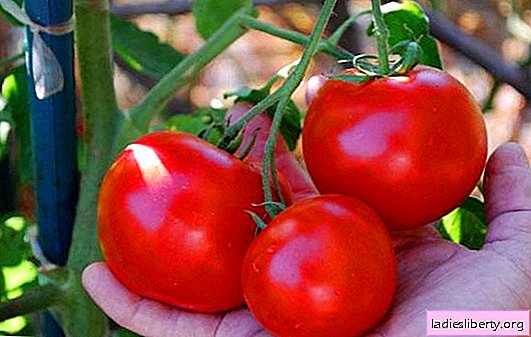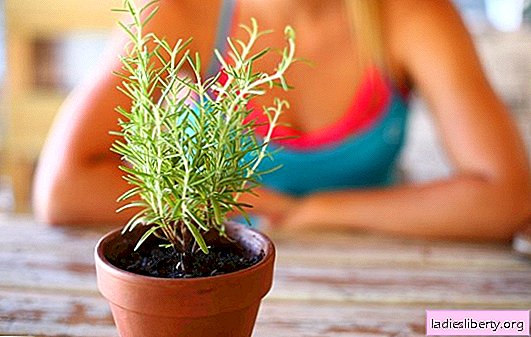
German ripening Red Riding Hood tomato is suitable for cultivation in greenhouses, open ground and not even on the balcony. A novice gardener can also get a crop of delicious tomatoes. The variety has established itself as unpretentious to the conditions of detention. This and much more will be discussed later.
Description of the variety and purpose of the tomato "Little Red Riding Hood"
Tomato belongs to early ripening and high-yielding varieties. The plant forms a low bush with powerful shoots and dark green leaves, which is not necessary to tie.
As you can see in the photo, the Little Red Riding Hood tomatoes are of medium size, rounded, formed by brushes of 3-5 pieces. Ripe fruits are bright red in color, fragrant. The pulp of tomatoes is juicy, practically does not contain seeds, tastes sweet and sour. The skin is thin, delicate. From one bush it is possible to remove up to 2 kg of fruits, which is good for early ripening varieties. Fruiting begins 3 months after planting.
Variety "Little Red Riding Hood" salad purpose. Fresh fruits are not stored for long and are not suitable for full-canning due to the thin skin. But from them you can cook delicious ketchups, dressings and other preparations.
Advantages and disadvantages of the early ripening variety
Tomato "Little Red Riding Hood" has virtually no flaws. This is an unpretentious culture, which has several advantages:
· Easily tolerates a short-term decrease in temperature;
· Rarely sick even with thickened landings;
· Has increased resistance to late blight;
· Does not require pinching;
· Responds well to dressing.
The compact size of the bushes allows you to grow tomatoes on the balcony in boxes, which allows you to take fresh fruits from early summer to late autumn. It is better to collect tomatoes fully ripened, since during storage they do not gain taste. Of course, getting a high yield with this method of cultivation does not work.
Planting seeds of the Little Red Riding Hood variety for seedlings and tomato care
In the southern zone of Russia, tomatoes can be grown by sowing seeds directly into the ground, but in other regions it is better to prepare seedlings. They begin to sow seeds not earlier than March-April. For this, the seeds are pre-treated and planted:
1. The day before planting, the seeds are soaked in a growth stimulator or a solution of potassium permanganate. This speeds up the process of germination and disinfects planting material.
2. Dried seeds are sown in nutritious soil for vegetable crops, which can be bought at any store or prepared independently.
3. The depth of seeding is about 1.5 cm.
With this method of planting, the seeds germinate for 3-5 days. Growth stimulants may well be replaced with aloe juice or sugar syrup. For sowing, choose fresh seeds that have been lying for no more than 3 years. The soil for seedlings should be loose, moisture permeable. To prepare the soil yourself, mix the turf and garden soil in equal proportions, add the washed river sand of a large fraction, ash and superphosphate.
Before seedlings appear, maintain the temperature in the room to 25 ° C, after which it must be lowered to 18 ° C. After 7 days, the temperature is returned to around 20-22 ° C. This will help the seedlings not to stretch. All this time, seedlings are watered with warm, settled water as needed. It is not necessary to moisten the soil too much, so that delicate plants do not get a black leg.

Dive tomatoes into separate containers as soon as the first pair of true leaves appears. After a dive, the pots are cleaned in a cool room, so that the seedlings take root better. After a week, seedlings can be fed with a liquid solution of mineral fertilizers.
Rules for planting tomatoes of the variety "Little Red Riding Hood" in the ground
Hardened seedlings are transferred to open ground in the second half of May. If planting is planned in a film greenhouse, then the timing may vary. The main condition is the absence of night frosts. When landing in balcony drawers adhere to the same terms.

Seedlings are planted in an ordinary way, according to the scheme of 65x45 cm. This distance will allow the plants to develop normally, prevent the appearance of fungal diseases. With a more crowded planting, bushes need careful care and regular pinching. Thickness often leads to pests.
The soil for planting tomatoes is prepared in advance, dug up by 20-25 cm, adding manure and humus. Fertile soil will only benefit plants.
Variety Care Features
Tomato varieties "Little Red Riding Hood" is not picky about care. The beds are watered infrequently, but the soil is well soaked to the full depth of the roots. On fertile soils, plants do not need fertilizing; in other cases, it will be necessary to fertilize the bushes 2-3 times per season.
As a fertilizer, liquid organomineral mixtures are used, for example, Humate +7 iodine or chicken manure infusion, mullein. The interval between dressings is from 15 to 20 days. The last top dressing is carried out two weeks before the harvest.
In addition to watering and top dressing, you will need to loosen the soil between the beds every 7-10 days or after each watering. This will provide oxygen to the roots. Loosen the crust to a depth of not more than 5 cm, otherwise you can damage the surface roots of the plant.
Disease Prevention and Pest Control on Red Riding Hood Tomatoes
The variety is declared as resistant to disease, but prevention still does not hurt, especially if the plants are in the greenhouse. The fact is that over several years pathogenic bacteria accumulate in the greenhouse. To avoid infection of tomatoes, the topsoil must be removed and laid fresh, more fertile. In the fall, after harvesting, the walls of the greenhouses are well washed, treated with chemicals.
A good measure for the prevention of various diseases is crop rotation. Experienced gardeners highly recommend not planting tomatoes after eggplant, peppers, potatoes.
The best predecessors for tomatoes are:
Root crops;
Beans
· cabbage;
· greenery.
At the first sign of a disease, spray the beds with bio-products, such as phytosporin.
With outbreaks of late blight, drugs with a high copper content will help. To stop the development of the disease, you will need several treatments.

Mulching of beds, weeding of weeds will help to avoid fungal diseases. As mulch, you can use peat, humus or straw.
Of the pests, the most dangerous for tomato are:
· Aphids;
Thrips;
Whitefly;
Spider mite.
They feed on the cell sap of the plant, slowing down and stopping its growth. With a large number of pests, they are treated with pesticides. If pests appeared when there are already fruits on the bushes, then it is better to use alternative methods. Several times do spraying with infusion of celandine, onion peel or chamomile. Intervals between treatments 5-7 days.
If slugs have appeared in the greenhouse or in the garden, then the pests are collected by hand, and the soil around the bushes is sprinkled with ground red pepper, crushed by egg shells.











